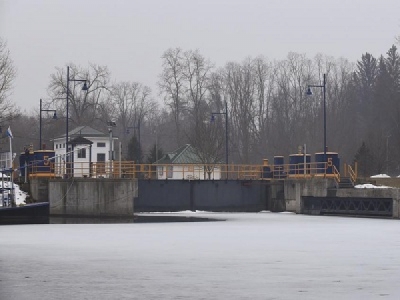
Posted on April 3, 2018
By Stephen Williams, The Daily Gazette
The U.S. Environmental Protection Agency has puts its review of whether Hudson River PCB dredging has been successful on hold while it evaluates new information from New York state, EPA Regional Administrator Pete Lopez said Thursday.
PCBs are a suspected carcinogen.
“Long story short from EPA, we are signaling that we don’t know everything,” Lopez told a meeting of the Hudson River PCBs Superfund Site Community Advisory Group at Saratoga Town Hall in Schuylerville.
Lopez, a former New York state assemblyman from Schoharie who was named regional EPA administrator last September, said he’s working hard to bridge the gaps between EPA and the state Department of Environmental Conservation over whether the $1.7 billion river cleanup has worked.
The EPA, which has been doing a mandated review of the General Electric-funded cleanup for more than a year, has preliminarily concluded the dredging has worked as planned, though it will be more than 50 years before fish from the river could be eaten on a routine basis.
The state DEC has concluded the dredging has failed to improve the environment sufficiently, and in December Gov. Andrew M. Cuomo threatened to sue the EPA if it said the cleanup was successful. The state wants further remediation.
But the EPA-DEC relationship appears to be improving, with Lopez noting that he and DEC Commissioner Basil Seggos ave been friends since Seggos helped oversee the state’s response to Tropical Storm Irene in 2011.
The DEC last year took 1,800 sediment samples from the river, which EPA officials at the time said wasn’t needed. Lopez said EPA needs time to evaluate that information.
“We’re very much appreciate of this pause the regional administrator has brought about,” said Martin Brand, DEC’s deputy commissioner for environmental remediation. “We have a little bit of new-found collaborate environment in working with the EPA.”
Lopez also told the roughly 60 people assembled that he’s spoken directly with EPA Administrator Scott Pruitt about the Hudson River cleanup, and that Pruitt, who has often faced criticism for looking to down-size the EPA’s mission, is strongly in favor of taking on cleanups of polluted sites like the Hudson River.
“The administrator is passionate about the Superfund program and EPA’s role in facilitating these complicated cleanups,” Lopez said in an interview after a three-hour session with the citizens’ group. “He wants to be comfortable that the remedy is going to be protective of the environment.”
He said both he and Pruitt struggle with how long the dredging will take to improve fish health, though the final decision will be made based on science and law.
“The best analogy I can draw is, we look at the river as an organism, a human body, and we did some surgery on that body with the dredging,” Lopez said. “The question is, was there enough dredging to create a causal change and restore the river to full health, and that’s where we are right now.”
Advocates, however, continue to urge a resumption of dredging in the river and in areas never dredged, like the historic Champlain Canal that runs through Schuylerville but once channeled water from the Hudson.
“Our children’s children’s children’s cleanup is what we’re doing right now, and we don’t want our children’s children to look back and say ‘Wow, we could have done more back in 2017,'” said Althea Jones, an attorney with Hudson Riverkeeper, a Poughkeepsie-based environmental group.
EPA officials acknowledge that PCBs from the GE plants that discharged them are found in the river all the way to New York City, though in lower concentrations than the “hot spots” that were dredged between 2009 and 2015.
The PCBs — polychlorinated biphenyls — were discharged from GE capacitor plants in Fort Edward and Hudson Falls between 1946 and 1977. Their use was banned in 1977. GE paid for dredging under a 2002 EPA order.
While in-river dredging may be completed, EPA continues to test floodplains and standing waters, including the historic canal for any contamination. Testing alone is expected to last for years, and GE potentially is responsible for more cleanup.
“This is a long journey and we want you to know we are focused on it,” Lopez said.
As administrator of EPA Region 2, Lopez oversees EPA activies in New York, New Jersey, Puerto Rico and the U.S. Virgin Islands.
“I’m very impressed with him. He seems like a very open, concerned guy,” said Saratoga Town Supervisor Tom Wood.
Julia Stokes of the Schuylerville Chamber of Commerce said the pause in the EPA review means there will be more time for businesses and residents to make arguments for why additional dredging in areas like the Champlain Canal is needed.
Source: The Daily Gazette





